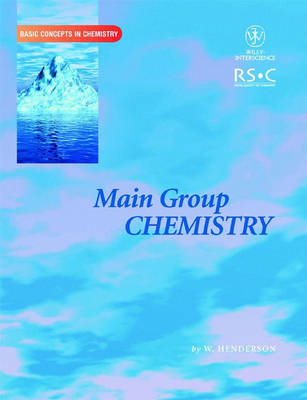
Main Group Chemistry
John Wiley & Sons Inc (Verlag)
978-0-471-22478-5 (ISBN)
- Titel ist leider vergriffen;
keine Neuauflage - Artikel merken
"Main Group Chemistry" covers the chemistry of the s and p block elements, together with a brief chapter on the chemistry of zinc, cadmium, and mercury, often classified as main group elements. The Periodic Table is an important predictive tool in main group chemistry and in this book forms the basis for describing the trends and variations in the chemistry of elements.
1. Some Aspects of Structure and Bonding in Main Group Chemistry.1.1 Introduction.1.2 Ionization Energy, Electron Affinity and Electronegativity.1.3 Periodic Trends among the Main Group Elements.1.4 Valence Shell Electron Pair Repulsion Theory.1.5 Molecular Orbital Theory.2. The Chemistry of Hydrogen.2.1 Introduction.2.2 The Element.2.3 The Chemistry of Hydrogen.2.4 Hydrides.2.5 Compounds containing Hydrogen formally as H+.2.6 The Hydrogen Bond.3. The Group 1 (Alkali Metal) Elements: Lithium, Sodium, Potassium, Rubidium, Caesium and Francium.3.1 Introduction and Oxidation State Survey.3.2 The Elements.3.3 Chemistry of the Alkali Metals.3.4 Simple Salts of the Alkali Metals.3.5 Compounds with Oxygen and Sulfur.3.6 Compounds with Nitrogen.3.7 Hydrides.3.8 Compounds with Carbon.3.9 Alkali Metal Complexes.3.10 Similarities in the Chemistry of Lithium and Magnesium.4. The Group 2 Elements: Beryllium, Magnesium, Calcium, Strontium, Barium and Radium.4.1 Introduction and Oxidation State Survey.4.2 The Elements.4.3 Simple Compounds and Salts.4.4 Compounds with Oxygen and Sulfur.4.5 Compounds with Nitrogen.4.6 Hydrides.4.7 Compounds with Carbon.4.8 Group 2 Metal Complexes.4.9 Similarities in the Chemistry of Beryllium and Aluminium.5. The Group 13 Elements: Boron, Aluminium, Gallium, Indium and Thallium.5.1 Introduction and Oxidation State Survey.5.2 The Elements.5.3 Chemistry of the Elements.5.4 Borides.5.5 Halides.5.6 Hydrides and Organometallic Compounds.5.7 Oxides, Hydroxides and Oxyanions.5.8 Compounds with Groups 15 and 16 Elements.5.9 Aquated and Related Complex Cations.6. The Group 14 Elements: Carbon, Silicon, Germanium, Tin and Lead.6.1 Introduction and Oxidation State Survey.6.2 The Elements.6.3 Chemistry of the Elements.6.4 Group 14 Hydrides and Organometallic Compounds.6.5 Group 14 Halides.6.6 Carbides and Silicides.6.7 Oxides.6.8 Sulfides, Selenides and Tellurides.6.9 Polyatomic Anions of the Group 14 Elements.7. The Group 15 (Pnictogen) Elements: Nitrogen, Phosphorus, Arsenic, Antimony and Bismuth.7.1 Introduction and Oxidation State Survey.7.2 The Elements.7.3 Hydrides.7.4 Oxides.7.5 Sulfides.7.6 Oxyanions and Oxyacids.7.7 Halides.7.8 Nitrides and Phosphides.8. The Group 16 (Chalcogen) Elements: Oxygen, Sulfur, Selenium, Tellurium and Polonium.8.1 Introduction and Oxidation State Survey.8.2 The Elements.8.3 Hydrides and Related Species.8.4 Halides.8.5 Oxides.8.6 Oxyhalides of Sulfur, Selenium and Tellurium.8.7 Oxyacids of Sulfur, Selenium and Tellurium.8.8 Polychalcogen Cations.9. The Group 17 (Halogen) Elements: Fluorine, Chlorine, Bromine, Iodine and Astatine.9.1 Introduction and Oxidation State Survey.9.2 The Elements.9.3 Chemistry of the Elements.9.4 Hydrogen Halides, HX, and Halide Salts, X- .9.5 Halogen Oxides.9.6 Oxyacids and Oxyanions of the Halogens.9.7 Interhalogen Compounds.9.8 The Chemistry of Astatine.10. The Group 18 (Noble Gas) Elements: Helium, Neon, Argon, Krypton, Xenon and Radon.10.1 Introduction and Oxidation State Survey.10.2 The Elements.10.3 Noble Gas Halides.10.4 Reactions of Noble Gas Fluorides with Fluoride Ion Acceptors and Donors.10.5 Xenon-Oxygen Compounds.10.6 Xenon and Krypton Compounds with Bonds to Elements other than O and F.11. The Group 12 Elements: Zinc, Cadmium and Mercury.11.1 Introduction.11.2 The Elements.11.3 Chemistry of the Elements.11.4 Halides.11.5 Chalcogenides and Related Compounds.11.6 Oxygen Compounds.11.7 Formation of Coordination Complexes.11.8 Low-valent Compounds.12 Selected Polymeric Main Group Compounds.12.1 Introduction.12.2 Polyphosphates.12.3 Silicates.12.4 Silicone Polymers.12.5 Polyphosphazenes.Further Reading.Answers to Problems.Subject Index.
| Erscheint lt. Verlag | 26.2.2003 |
|---|---|
| Reihe/Serie | Basic Concepts in Chemistry |
| Zusatzinfo | index |
| Verlagsort | New York |
| Sprache | englisch |
| Maße | 189 x 246 mm |
| Gewicht | 454 g |
| Themenwelt | Naturwissenschaften ► Chemie ► Anorganische Chemie |
| ISBN-10 | 0-471-22478-2 / 0471224782 |
| ISBN-13 | 978-0-471-22478-5 / 9780471224785 |
| Zustand | Neuware |
| Haben Sie eine Frage zum Produkt? |
aus dem Bereich


